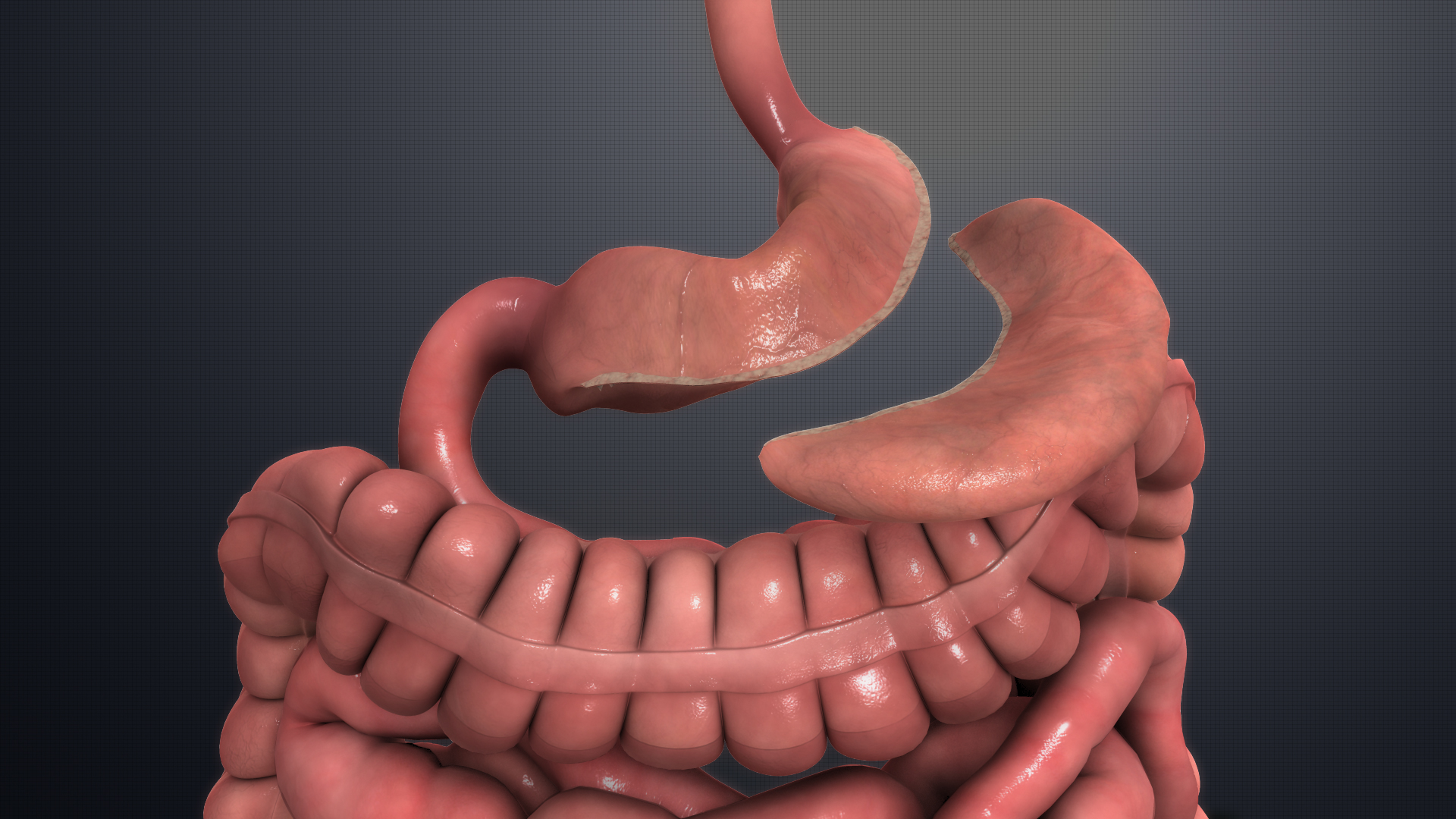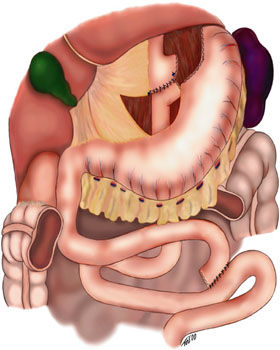|
SIPS Surgery
Stomach Intestinal Pylorus-Sparing (SIPS) surgery is a type of weight-loss surgery. It was developed in 2013 by two U.S. surgeons, Daniel Cottam from Utah and Mitchell S. Roslin from New York. It is substantively the same procedure as the SADI surgery. Technique SIPS surgery is a modified version of duodenal switch (DS) surgery. The SIPS surgery involves the creation of a 300-cm common channel with a single-anastomosis duodenal enterostomy. Advantages #Greater weight loss than sleeve gastrectomy (SG). #Greater weight loss than Roux-en-Y gastric bypass (RYGB). #Weight loss is similar to DS. #One of the best revision surgeries after failed RYGB, adjustable gastric banding (ABG), and SG. #Better T2DM remission than RYGB and SG. #Better cholesterol resolution than RYGB. #No Roux limb side effects. #Similar nutritional problems to RYGB and less than DS. #Low risk of intestinal obstruction compared to RYGB and DS. #No Dumping syndrome, unlike RYGB. #No marginal ulcers, unlike RYGB ... [...More Info...] [...Related Items...] OR: [Wikipedia] [Google] [Baidu] |
Bariatric Surgery
Bariatric surgery (or weight loss surgery) includes a variety of procedures performed on people who are obese. Long term weight loss through the standard of care procedures ( Roux en-Y bypass, sleeve gastrectomy, and biliopancreatic diversion with duodenal switch) is largely achieved by altering gut hormone levels responsible for hunger and satiety, leading to a new hormonal weight set point. Bariatric surgery is the most effective treatment causing weight loss and reducing complications of obesity. As of October 2022, the American Society of Metabolic and Bariatric Surgery (ASMBS) and International Federation for the Surgery of Obesity (IFSO) recommend bariatric surgery for adults with a body mass index (BMI) >35, regardless of obesity-associated conditions, and recommend considering surgery for people with BMI 30.0-34.9 who have metabolic disease. This is a recent change in guidelines (October 2022), so other guideline-producing organizations and health insurance plans m ... [...More Info...] [...Related Items...] OR: [Wikipedia] [Google] [Baidu] |
SADI-S Surgery
SADI-S (Single anastomosis duodeno–ileal bypass with sleeve gastrectomy) is a bariatric surgical technique to address metabolic disorders and to lose weight. It is a variation on the Duodenal Switch surgery, incorporating a vertical sleeve gastrectomy with a gastric bypass technique. The SADI-S is a type of bariatric surgery with a single surgical anastomosis. It has a restrictive component when reducing the greater curvature of the stomach, but especially a malabsorptive component, as the common channel is also reduced. The objective of this surgical technique is to lessen the intestinal loop where nutrients are absorbed. Technique It can be performed by laparotomy or laparoscopy. A small gastric sleeve is created by sectioning the greater curvature of the stomach, such as in the sleeve technique. Subsequently, the duodenum is transected respecting the pylorus. A duodenum-intestinal anastomosis is carried out between and from the ileocecal valve. Therefore, this distance ... [...More Info...] [...Related Items...] OR: [Wikipedia] [Google] [Baidu] |
Duodenal Switch
The duodenal switch (DS) procedure, gastric reduction duodenal switch (GRDS), is a weight loss surgery procedure that is composed of a restrictive and a malabsorptive aspect. The restrictive portion of the surgery involves removing approximately 70% of the stomach (along the greater curvature) and most of the duodenum. The malabsorptive portion of the surgery reroutes a lengthy portion of the small intestine, creating two separate pathways and one common channel. The shorter of the two pathways, the digestive loop, takes food from the stomach to the common channel. The much longer pathway, the biliopancreatic loop, carries bile from the liver to the common channel. The common channel is the portion of small intestine, usually 75-150 centimeters long, in which the contents of the digestive path mix with the bile from the biliopancreatic loop before emptying into the large intestine. The objective of this arrangement is to reduce the amount of time the body has to capture calor ... [...More Info...] [...Related Items...] OR: [Wikipedia] [Google] [Baidu] |
Sleeve Gastrectomy
Sleeve gastrectomy is a surgical weight-loss procedure in which the stomach is reduced to about 15% of its original size, by surgical removal of a large portion of the stomach along the greater curvature. The result is a sleeve or tube like structure. The procedure permanently reduces the size of the stomach, although there could be some dilation of the stomach later on in life. The procedure is generally performed laparoscopically and is irreversible. A meta-analysis of 174,772 participants published in The Lancet in 2021 found that bariatric surgery was associated with 59% and 30% reduction in all-cause mortality among obese adults with or without type 2 diabetes respectively. This meta-analysis also found that median life-expectancy was 9.3 years longer for obese adults with diabetes who received bariatric surgery as compared to routine (non-surgical) care, whereas the life expectancy gain was 5.1 years longer for obese adults without diabetes. Procedure Sleeve gastrec ... [...More Info...] [...Related Items...] OR: [Wikipedia] [Google] [Baidu] |
Gastric Bypass Surgery
Gastric bypass surgery refers to a technique in which the stomach is divided into a small upper pouch and a much larger lower "remnant" pouch and then the small intestine is rearranged to connect to both. Surgeons have developed several different ways to reconnect the intestine, thus leading to several different gastric bypass procedures (GBP). Any GBP leads to a marked reduction in the functional volume of the stomach, accompanied by an altered physiological and physical response to food. The operation is prescribed to treat morbid obesity (defined as a body mass index greater than 40), Diabetes mellitus type 2, type 2 diabetes, hypertension, sleep apnea, and other comorbid conditions. ''Bariatric surgery'' is the term encompassing ''all'' of the surgical treatments for morbid obesity, not just gastric bypasses, which make up only one class of such operations. The resulting weight loss, typically dramatic, markedly reduces Comorbidity, comorbidities. The long-term mortality ra ... [...More Info...] [...Related Items...] OR: [Wikipedia] [Google] [Baidu] |
Adjustable Gastric Band
A laparoscopic adjustable gastric band, commonly called a lap-band, A band, or LAGB, is an inflatable silicone device placed around the top portion of the stomach to treat obesity, intended to decrease food consumption. Adjustable gastric band surgery is an example of bariatric surgery designed for obese patients with a body mass index (BMI) of 40 or greater—or between 35 and 40 in cases of patients with certain comorbidities that are known to improve with weight loss, such as sleep apnea, diabetes, osteoarthritis, GERD, hypertension (high blood pressure), or metabolic syndrome, among others. In February 2011, the United States Food and Drug Administration (FDA) expanded approval of adjustable gastric bands to patients with a BMI between 30 and 40 and one weight-related medical condition, such as diabetes or high blood pressure. However, an adjustable gastric band may be used only after other methods such as diet and exercise have been tried. Working principle The inflat ... [...More Info...] [...Related Items...] OR: [Wikipedia] [Google] [Baidu] |
Diabetes Mellitus
Diabetes, also known as diabetes mellitus, is a group of metabolic disorders characterized by a high blood sugar level (hyperglycemia) over a prolonged period of time. Symptoms often include frequent urination, increased thirst and increased appetite. If left untreated, diabetes can cause many health complications. Acute complications can include diabetic ketoacidosis, hyperosmolar hyperglycemic state, or death. Serious long-term complications include cardiovascular disease, stroke, chronic kidney disease, foot ulcers, damage to the nerves, damage to the eyes, and cognitive impairment. Diabetes is due to either the pancreas not producing enough insulin, or the cells of the body not responding properly to the insulin produced. Insulin is a hormone which is responsible for helping glucose from food get into cells to be used for energy. There are three main types of diabetes mellitus: * Type 1 diabetes results from failure of the pancreas to produce enough insulin due ... [...More Info...] [...Related Items...] OR: [Wikipedia] [Google] [Baidu] |
Gastric Dumping Syndrome
Dumping syndrome occurs when food, especially sugar, moves too quickly from the stomach to the duodenum—the first part of the small intestine—in the upper gastrointestinal (GI) tract. This condition is also called rapid gastric emptying. It is mostly associated with conditions following gastric or esophageal surgery, though it can also arise secondary to diabetes or to the use of certain medications; it is caused by an absent or insufficiently functioning pyloric sphincter, the valve between the stomach and the duodenum. Dumping syndrome has two forms, based on when symptoms occur. Early dumping syndrome occurs 10 to 30 minutes after a meal. It results from rapid movement of fluid into the intestine following a sudden addition of a large amount of food from the stomach. The small intestine expands rapidly due to the presence of hypertonic/ hyperosmolar contents from the stomach, especially sweet foods. This causes symptoms due to the shift of fluid into the intestinal lumen, w ... [...More Info...] [...Related Items...] OR: [Wikipedia] [Google] [Baidu] |



